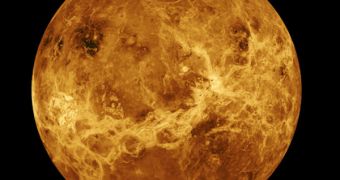As part of the New Frontiers Program 2009 Announcement of Opportunity, the NASA Ames Research Center, in Moffett Field, California, has submitted a number of scientific proposals to the space agency. Two of the projects have now qualified for the second stage of the competition, which means that the chances of them actually turning into NASA missions have increased considerably. Scientists at Ames have to complete preliminary studies on both of their projects by the end of this year, and the vehicles, if selected, need to be ready for launch by December, 2018, Space Fellowship reports.
The first proposal that NASA accepted, and is about to fund with approximately $3.3 million, is the Surface and Atmosphere Geochemical Explorer (SAGE) mission to Venus. Experts at Ames say that an orbiter would release a descent module through the planet's atmosphere. As it heads for the surface, the probe will conduct numerous analyses of the atmosphere's chemical composition, and it will also look at the planet's meteorology. Upon landing, the craft will use a special tool to expose a portion of the Venusian soil for analysis. Additional instruments will look at the composition of the soil, and determine its nature, origins and history. This will be of great importance for understanding how the planet formed.
“We can build a coherent picture of Venus’ atmospheric profile by taking direct measurements in unprecedented accuracy and resolution with a unique set of sensors as SAGE flies through the atmosphere. Wind speed, direction and the rate at which the atmosphere overturns are critical to understanding the chemistry of the atmosphere and how it interacts with the surface,” Ames research scientist Tony Colaprete says.
The second selected proposal is the Origins Spectral Interpretation Resource Identification Security Regolith Explorer spacecraft, or OSIRIS-REx. This would be a mission to a near-Earth object (NEO) that would feature an orbiting, sample-collection, and return stage. First off, the craft will rendezvous with a selected asteroid, and start orbiting it for a while. During this stage, scientific instruments would conduct extensive measurements of the space rock's topography, composition and other physical characteristics. Special devices would then collect up to two ounces of material from its surface, and the package would be sent back to Earth, for a direct analysis.
“We are hoping to find out what the true composition of organic-rich asteroids are and find out what sort of impact hazards and potential space resources they represent. When the SRC (sample-return capsule) re-enters Earth’s atmosphere, the spacecraft lets atmospheric air into the capsule. However, we don’t want that air to also suck in contamination that will ruin the samples,” Ames research scientist Scott Sandford explains.
“These are projects that inspire and excite young scientists, engineers and the public. These three proposals provide the best science value among eight submitted to NASA,” Ed Weiler concludes. He is the associate administrator of the Science Mission Directorate, at the NASA Headquarters, in Washington DC.

 14 DAY TRIAL //
14 DAY TRIAL //